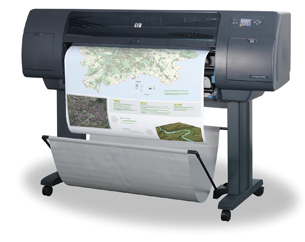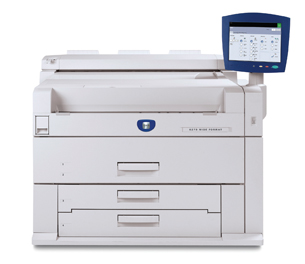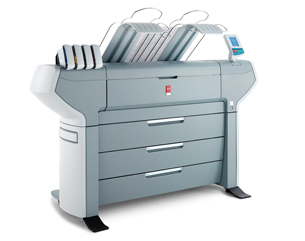Bigger, Bolder Printers Fill the Market
Fast, affordable color comes to large-format printers tailor-made for technical documents.
Latest News
June 30, 2009
By David Essex
 For high-volume engineering and design uses, HP has released the DesignJet 4020 (pictured) and 4050 printers with onboard processing boosted by hard drives and memory 2x that of the T1120. |
Large-format printers that are fast are commonplace in engineering. What isn’t so common, however, is color, but recent advances are changing color’s role in technical communication.
Their price premiums shrinking, color printers can reproduce black and white and gray scales as well as their monochrome counterparts, and their cost-per-page is comparable if you’re mostly printing line drawings with little or no color.
The move to color is usually a move to inkjet, and HP dominates the market, although Epson, Océ, and especially Canon are players. Toner-based, or LED, printers, are the monochrome mainstay, with KIP America, Kyocera Mita, Océ, Ricoh, Seiko Infotech, and Xerox sharing the segment.
“Océ’s really the only crossover company that does both,” says Tim Greene, director of wide-format and jetting technologies at InfoTrends. Greene calls the KIP 3100 multifunction unit “a category leader” in monochrome LEDs.
But color LEDs are so expensive that they most often appeal to reprographic and other high-volume, quality-conscious customers. They are usually 3-4 times faster, largely because they lack the drying step that is inkjet’s Achilles’ heel, and thus don’t require more expensive coated paper. Inkjet vendors have greatly improved drying, however, with new paper and ink technologies, Greene says, while boosting speed and resolution with wider, more precise nozzles. Canon and HP have economy modes that put less ink on paper, saving drying time and ink costs.
 The compact Xerox 6279 is a 600dpi, monochrome printer and can print up to nine pages a minute while scanning at 6ips with its optional monochrome scanner, which is upgradeable to color. |
Buying Advice
Large format starts at 24 in. wide, though 36 in. is the minimum in most technical environments. Many vendors sell 24- and 44-in. options, and a few go wider. Printers come in two configurations: multifunction (MFPs) or stand-alone. MFPs can replace analog copy machines by combining copier-like scanners and printers in a more compact unit. Higher-volume printers have multiple paper rolls that switch in automatically when one runs out.
Beware mismatches between the color abilities of scanner and printer. Some spec sheets tout color scanning, but the printer is actually monochrome.
Mechanical speed ratings can be misleading. What matters is “click to plunk”—the time between the mouse click and the plunk of paper in the tray. Printers vary in the amount of file processing they do onboard instead of on the computer. The best way to gauge throughput is to bring your files to the showroom and run print jobs yourself. Greene suggests quantifying monthly volume and extrapolating it to page-per-minute claims to avoid over- or underestimating your need for speed.
The baseline resolution for wide-format monochrome is 600dpi, with some Epson printers reaching 2,880dpi, according to Greene. By comparison, the sweet spot for color is 1,200 to 2,400dpi, says Marc Jongen, a worldwide marketing manager in Hewlett-Packard’s technical printing division, and adding photorealistic rendering isn’t possible at 600dpi. Higher resolutions reduce performance, and the tradeoff isn’t usually worth the negligible increase in image quality. Xerox, for example, sells printers that go up to 1,440dpi, but most users are happy with 720, says Karen Serrano, Xerox’s worldwide marketing and training manager for wide-format products.
 The Océ ColorWave 600 is a mid-volume LED printer with a six-roll capacity. Some see it as a best-of-both-worlds replacement for separate monochrome LED copiers and color inkjet machines. |
CANON
Already HP’s biggest challenger in color inkjets, according to Greene, Canon has upgraded its imagePROGRAF line substantially in the past year, targeting both the reprographic and technical markets. Introduced last fall, the 44-in. iPF810 and 820 can print two pages per minute at 1,200dpi and come bundled with RATIO’s CADSTATION PS+ workflow software for managing a variety of graphical and technical file formats.
HEWLETT-PACKARD
The longtime leader in office color inkjets, HP has been pushing further into specialized, wide-format markets. It introduced three stand-alone and three multifunction models in March 2009 and upgraded its inkjet control software to LED-like functions, Greene says.
“The new printers have major improvements in their productivity,” says Jongen. He notes that while mechanical speeds haven’t changed from earlier models, onboard file processing has been improved. This helps minimize the time waiting in line, and smaller file sizes free your workstation more quickly for other work. Web-based control software makes it easier to track consumables remotely, he says, and service contracts are rarely needed, unlike with LEDs.
Of the three new MFPs, the one targeting engineers is the DesignJet T1120 SD MFP ($16,495), a 1,200dpi color unit that contains a contact image sensor (CIS) scanner, a more affordable technology than the charged-coupled device (CCD) technology in many scanners.
“It’s great for line drawings for CAD applications,” Jongen says. The SD unit sells for roughly $5,000 less than the previous comparable model and its small-footprint, all-in-one design is perhaps best suited for workgroups that have limited space possibilities.
A $21,495 HD version uses CCD for sharper scan resolutions of up to 400dpi, twice that of the SD. Both can print line drawings at slightly fewer than two D-size pages per minute, and use a six-color system that adds gray and matte black to the usual CMYK. Both come in 24- or 44-in.-wide versions. You can get the printer by itself for as little as $3,595.
For high-volume engineering and design uses, HP also released the DesignJet 4020 and 4050, printers with onboard processing boosted by hard drives and memory with more than twice the capacity of the T1120.
The company also introduced large-format “cockle-free” coated papers (they stay flat after printing, even with lots of ink) and recycled bond papers that improve print quality and are geared to technical applications, according to Jeanette Volk, HP’s sales development manager for large-format media.
HP also sells entry-level printers for less than $2,000 for individual users and small workgroups, such as the 24-in. DesignJet 110plus and 36- and 42-in. 510 model.
OCé
Noting a trend away from centralized print rooms and toward distributed printing, Océ has designed its software interface and printer controls to make it easier for walk-up users to scan, copy, or print, says Penny Holland, director of business development at Océ. The printers have dual hard drives and other features that allow them to scan, process, and print multiple files simultaneously and avoid bottlenecks. On monochrome models, which are all LEDs, Radiant Fusing technology replaces heated rollers to provide instant-on printing and better reliability and energy efficiency, according to Océ.
LED printer and multifunction models cover the gamut of capacities, from the entry-level, TDS320, which scans, copies, and prints up to 9 linear feet per second, to the 600x1200, mid-to-high-volume TDS700 and high-end TDS800 printers.
For color, Océ sells the TCS 300 and 500 inkjets and some LEDs. Holland says engineers should consider the ColorWave 600, a mid-volume LED printer with a six-roll capacity, as a best-of-both-worlds replacement for separate monochrome LED copiers and color inkjet machines.
The newest offering, introduced in late April, is the PlotWave 300. The printer-only version costs $17,000, while multifunction systems cost $22,000 to $23,700 depending on the paper rolls. Holland says the top-mounted scanner in the multifunction version makes it well suited for walk-up, departmental use.
XEROX
Xerox touts its ease of use, thanks in large part to a simple graphical user interface, along with a modular approach that makes it easy to add features and capacity as needs change.
Its lead product in the low-volume arena is the Xerox 6204, a monochrome LED-based MFP that outputs 4 to 5 pages per minute, Serrano says. It starts at $18,325.
The Xerox 6279, a 600dpi, monochrome unit, can print up to nine pages a minute while scanning at 6ips with its optional monochrome scanner, which is upgradeable to color on site. It starts at $23,000 and is considered a mid-range volume unit, and will replace the 6050A and 510, Serrano says. “Over time, the 6279 will replace all products worldwide,” because, she says, the 6279 is more compact than previous, and competing, multifunction systems. “In the past, they might not have been able to get that multifunctionality in a single footprint.”
Serrano says Xerox’s high-volume machine is the 721, which spits out a whopping 22 pages per minute. Priced at $75,200 for its most popular configuration, it appeals mostly to reprographic businesses, but is sold into some high-volume engineering shops, she says.
Whether you need to print lots of color or high-quality documents, there’s almost certainly a large-format machine to fit your needs.
More Info:
Canon USA
Lake Success, NY
Epson America
Long Beach, CA
Hewlett-Packard
Palo Alto, CA
InfoTrends
Weymouth, MA
KIP America
Novi, MI
Kyocera Mita America
Fairfield, NJ
Océ
Trumbull, CT
Ricoh Americas
West Caldwell, NJ
Xerox
Norwalk, CT
David Essex has covered information technology for 23 years. He was a BYTE editor and has written for Computerworld, PC World, and numerous other publications. Send him an e-mail about this article to [email protected].
Subscribe to our FREE magazine, FREE email newsletters or both!
Latest News
About the Author
DE’s editors contribute news and new product announcements to Digital Engineering.
Press releases may be sent to them via [email protected].






